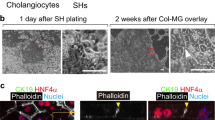Abstract.
When cultured together in a primary serum-free hormone-free system, hepatocytes and exocrine pancreas cells from the carp, Cyprinus carpio, spontaneously establish unique morphological structures that do not occur in vivo. These structures include intercellular bile canaliculi between neighbouring hepatocytes and hybrid canaliculi between hepatocytes and pancreas cells. In vivo, carp hepatocytes form only unicellular bile canaliculi; hybrid canaliculi between hepatocytes and exocrine pancreas cells do not exist at all in nature. This study shows that, in an artificial environment, cells are able spontaneously to establish novel morphological structures that are absent in the animal from which the cells have been obtained.
Similar content being viewed by others
Author information
Authors and Affiliations
Additional information
Received: 3 January 1996 / Accepted: 17 March 1997
Rights and permissions
About this article
Cite this article
Vogt, G., Segner, H. Spontaneous formation of intercellular bile canaliculi and hybrid biliary-pancreatic canaliculi in co-culture of hepatocytes and exocrine pancreas cells from carp. Cell Tissue Res 289, 191–194 (1997). https://doi.org/10.1007/s004410050865
Issue Date:
DOI: https://doi.org/10.1007/s004410050865




